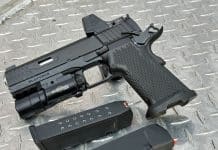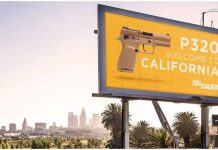 You’ve decided to purchase your first handgun and you realize you don’t have a clue what to get. You start asking friends and family what they recommend and you get as varied an answer as the people. You are lost and don’t know what to do. Hopefully, this guide will give you some insight on what to look for and how to make the right choice.
You’ve decided to purchase your first handgun and you realize you don’t have a clue what to get. You start asking friends and family what they recommend and you get as varied an answer as the people. You are lost and don’t know what to do. Hopefully, this guide will give you some insight on what to look for and how to make the right choice.
As you’ve noticed there are as many guns on the market as there are people. There is a reason for this. There is no one size fits all firearm out there. While some guns have more versatility than others, at the end of the day the physics of firearms means that one gun simply cannot do everything. This is the first aspect to decide on when choosing a new gun. What am I going to use this gun for? For the sake of brevity, we will be focused on handguns in the article, however, the questions asked for handguns are the same for long guns.
What is this gun for?
There are 3 main areas I will be categorizing for this question.
- Concealed Carry
- Home Defense
- Competition
Conceal Carry
A gun for concealed carry is going to be small, lightweight, and streamlined. Science says the smaller the firearm, the more felt recoil. No matter the caliber you choose, if you compare a larger gun to a similar smaller gun, of the same caliber, the amount of recoil felt will be greater in the smaller gun. Why is this important? No matter how you use the firearm that you choose, practice makes perfect. You are planning on using this gun to defend your life. So choose a gun in a caliber you will want to shoot often. Like any other skill in life you need to practice. It’s not like in the movies where you just pick a gun up and hit the bullseye. You need to train, a lot. Then realize that when the situation happens, adrenaline will crank up and you will not be able to think clearly. That’s why training and practice is so important. Muscle memory will take over allowing you to actually hit your target and defend yourself.
 All of this means when choosing a gun think about which you will be more likely to take to the range and practice with. Whether it is for concealed carry or home defense, big or small, you don’t want your choice to be one that you dread using. As a new shooter, you are going to want to choose a gun that is easy to shoot and enjoyable. You may have been able to be very comfortable with your grandfathers old .45 but put that same round into a small, thin, polymer framed carry pistol and it’ll become a whole other beast. Personally, I love the .45 caliber and have several large frame pistols for carrying openly in the woods or keeping at home. However, when it comes to a gun to carry, a 9mm or .38 is my choice. There are a number of small, concealable guns in these calibers out there that are actually fun to shoot and easy to use. With modern advancements in ammunition these calibers are extremely viable for use to defend you as well. Be sure whatever you choose, it is a gun that you can be proficient with.
All of this means when choosing a gun think about which you will be more likely to take to the range and practice with. Whether it is for concealed carry or home defense, big or small, you don’t want your choice to be one that you dread using. As a new shooter, you are going to want to choose a gun that is easy to shoot and enjoyable. You may have been able to be very comfortable with your grandfathers old .45 but put that same round into a small, thin, polymer framed carry pistol and it’ll become a whole other beast. Personally, I love the .45 caliber and have several large frame pistols for carrying openly in the woods or keeping at home. However, when it comes to a gun to carry, a 9mm or .38 is my choice. There are a number of small, concealable guns in these calibers out there that are actually fun to shoot and easy to use. With modern advancements in ammunition these calibers are extremely viable for use to defend you as well. Be sure whatever you choose, it is a gun that you can be proficient with.
Home Defense

The options are nearly limitless. You will have every gun dealer try to sell you their favorite sidearm as perfect gun to keep in the house. While this can seem overwhelming, try to organize your thoughts and the options to help narrow down the search. I recommend a larger framed pistol for home defense that you’re extremely proficient with. Something that has a higher capacity and options for low light accessories is also a huge benefit. Things like accessory rails and night sights are good examples and will help you immensely. The purpose of the home defense pistol is to protect you and your family in the case that someone decides to force their way in. Most of these situations happen at night, where light is low and you are more than likely half awake. You want something that will be easy to find in the dark, grab and use. Guns like Glock, Smith and Wesson M&P, and the Springfield Armory XD dominate this market. These are the kinds of firearms that officers carry and, if you are the outdoor type, you would open carry in the woods. Higher capacity (within your State’s laws) also give you more ammo for poor shooting in low light. With you half awake and your adrenaline pumping you’re going to have the accuracy of a Storm Trooper while trying to keep your family safe. Have more rounds between reloads means you will have more opportunities to hit you target and save your life. Other than that reliability and practice are key. With any gun, you want a manufacture with a good reputation for building a solid reliable firearm. Unless you drag the gun behind your vehicle or put 100,000 rounds a year through it, you should rely on it to last a lifetime. Take care of it with proper maintenance and buy something better than the cheapest thing you can find and you’ll have a gun you can rely on when the time comes.
Competition

These guns can cost you and require more thought and research. You don’t just jump into a production Ford and go to the racetrack. You build it to meet your individual needs and customize it to meet the rules of the match. Depending on what you compete in, a competition gun can have a lot of extras. Things like reflex sights, extended mag wells, extended controls, upgraded barrels and components can be done to a competition gun in order to better your odds. These tend to be either special builds or high-end production guns from well-known manufactures. Money is going to be key for these guns. They do cost a bit more.
Whatever the competition or desire, things to think about at this stage is your own personal strengths and weaknesses at the range. They get amplified in competition and having a pistol that matches your strengths and decreases your weaknesses will greatly benefit you. If you struggle with speed on reloads and extended mag release or slide stop will help increase your reload time. Time is also another factor in this area. Because of the customized nature of these guns, looking up and researching all the options available for your choice is wise. Know what’s out there and what you can do before spending money on something that you end up not liking. Also choosing a base gun that has a high number of aftermarket upgrades is key. You may love how your Taurus shoots and trust it, but if you want to compete in 3 Gun Open Class, you are going to want a lighter trigger, a reflex sight and extend mags. Something you are not going to find for that Taurus, but you can find for a Glock in droves.
How does this gun feel?

Fit is the most important component of the decision process. This is why visiting multiple gun stores and handling multiple guns is key. What fits my hand and what fits your hand can be very different. I teach a concealed carry class for my state, and part of my class is having my students come up to the front and handle each of the handguns I bring. At the end of the lesson I ask, “What was your favorite gun on the table?” Out of a class of 5 or 6 I inevitably get 5 or 6 answers. While none of these guns have been fired, a favorite is still chosen based off of just the feel of the gun in the hand. I’m a firm believer that the gun that feels the best will be the gun you shoot the best. In my years of selling guns I’ve been asked more times than I can count, “What’s your favorite?” I hate that question because I love them all and find use and reason for all of them. So, take your time. Hold the options, and if you can, go somewhere that will allow you to rent a few or better yet find someone that will let you try their gun out. It’ll be a huge step in making the right decision for you.
Look for things like width, finger grooves, grip angle and where the trigger contacts your finger. A good example of this is a gun I encountered one day at a good friend’s private range. Him, along with several of his co-workers, invited me to come over to shoot in preparation for an upcoming IDPA match. One of the guys there had a gun I had never seen before, or shot. As most gun guys are, he was very excited to let me try the pistol out. He had both a large frame and compact frame of the same gun, in the same caliber. I shot the large frame gun first and loved it. Shot it faster and more accurately than my own guns. I wanted one almost instantly. However, when I got to the compact gun things changed. Something in the size and design caused my finger to reach the trigger in such a way that I wasn’t able to naturally depress the trigger safety. Causing me to shoot, regrip, then shoot again. I tried the large frame pistol again to retest my theory and was able to run it flawlessly and accurately like it was part of my hand. This is one of those things that sometimes seeing is believing. We were both stumped but it is what it is. I would never be able to defend myself or compete with a gun I can’t properly grip and shoot. This is why holding, feeling, and trying a gun is so important before buying. Don’t just listen to your cop friend and go buy a Glock, cause that’s what he or she likes or because that’s what everybody has. Try them out for yourself and make your decision.
If you’re new to this, take your time. I know you are excited about getting a new gun but it’s not cheap and they can’t be returned. Make sure you feel comfortable with the gun and that it feels like an extension of yourself. It will take some time but you will soon learn what feels good and what doesn’t. Think about it this way. You don’t go out and buy a Honda without ever driving or even sitting in one just because several of your neighbors like theirs. You do some research and go check the vehicle out for yourself. See if you like it on the test drive. Same goes with a firearm. You will find the right match.
What caliber should I get?

As far as caliber goes, my main advice will be to go with the biggest you can handle. “Bigger is better” is a great adage but just because you can get a pistol in a .50 caliber doesn’t mean you should. The bigger the round the more felt recoil and the harder it will be to control. If you don’t enjoy shooting it you are less likely to want to shoot it. This is especially important with a conceal carry gun. I personally love the .45 caliber. It’s big and transfers a whole lot of kinetic energy, which creates more damage upon impact. This is why it’s my caliber of choice for home defense and as a sidearm when I’m in the woods hunting. That being said I’ve had a small, lightweight .45 for carry and I ended up trading it for a small .38. In that smaller frame it was much harder to control and really just worked me too much to enjoy it. With modern advances in ammo, using a smaller caliber like a .38, 9mm or .380 is now very much an option. My suggestion is to try a few things out. You may be able to handle a full frame .45 like a champ but, like me, you might find the smaller frame creates more work than you are willing to put up with.
Another factor in caliber to consider is ammo price and availability. Calibers like 9mm, .40 S&W, and .45 ACP are found everywhere and in large quantities. In doing your research you may hear of calibers like 10mm, .357 SIG, and .45 GAP. Some of these calibers have very loyal followings with their owners and can be argued that ballistically are superior to their common counterparts. However, go to your local big box store and ask if they have that caliber in stock and what the prices are. Because they do not have the larger following like the .9, .40 or .45 their ammo is much harder to find and also cost quite a bit more.
I’ve heard the debate many times over if the .22 is good enough for self-defense. My take on it is this. If that is all you can handle then it’s better than a knife. Caliber size is argued over as much as which is better, a Ford or a Chevy. Terms like stopping power, penetration, shot placement and many others are used to justify a person’s choice. Some people just don’t have the hand strength to handle even a 9mm or .380. If that’s the case with you then a .32 or .22 may be your only choice. The fun thing about smaller rounds is that they are easier to control making your accuracy more consistent. You may not be able to handle a larger round with more kinetic energy but you can put more rounds in center mass with a small round consistently. This is where trying guns out and shooting as much as you can, as often as you can is so important. Know your limitations, build your skills, and find that right match for you. Another option for the .22 caliber is for training purpose. The .22 is a very inexpensive round and are often found in bulk quantities. They are easy to shoot and a number of manufacturers have .22 conversions or .22 versions of the gun you choose to carry. This allows you to practice hold, trigger control and sight alignment with a cheaper, smaller round that you can shoot all day without fatigue.
Conclusion
Buying a new gun should be fun, but with so many options it can be overwhelming. Especially to someone that is new to these tools. You’re not expected to be an expert and talking with experts is a good idea. At the end of the day I will say that fit, feel, and control are the key factors in this decision. No one can tell you what to buy but can lead you in the right direction. Gun nuts can be loyal and will give you some friendly ribbing from time to time if your decision is different from theirs, but know that you are also in very loyal company. It is your right to defend yourself and own a firearm. No matter your justification or decision it is your right and your responsibility. Get a gun you are comfortable with and go have some fun. Practice safety constantly and take care of your firearm. It will take care of you.
Looking for more information, training and usage on firearms? Check out our Briefing Room series.
Retail options for your firearm selection – Rainier Arms, Cabela’s and Palmetto State Armory to name a few.













[…] Looking for more articles from our Blog? Check them out here. Also, learn what 3 Questions To Ask When Choosing The Right Handgun […]